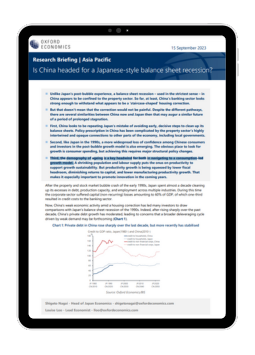Is China headed for a Japanese-style balance sheet recession?

After the property and stock market bubble crash of the early 1990s, Japan spent almost a decade cleaning up its excesses in debt, production capacity, and employment across multiple industries. Now, China’s weak economic activity amid a housing correction has led many investors to draw comparisons with Japan’s balance sheet recession of the 1990s.
What you will learn:
- Despite the different pathways, there are several similarities between China now and Japan then that may augur a similar future of a period of prolonged stagnation.
- First, China looks to be repeating Japan’s mistake of avoiding early, decisive steps to clean up its balance sheets.
- Second, like Japan in the 1990s, a more widespread loss of confidence among Chinese consumers and investors in the post-bubble growth model is also emerging.
- Third, the demography of ageing is a key headwind for both in navigating to a consumption-led growth model.
Tags:
Related Posts

Post
BoJ to raise its policy rate cautiously to 1% by 2028
We now project that the Bank of Japan will start to raise its policy rate next spring assuming another robust wage settlement at the Spring Negotiation. If inflation remains on a path towards 2%, the BoJ will likely raise rates cautiously to a terminal rate of around 1% in 2028.
Find Out More
Post
Japan inflation to rise to 1.8%, but downside risks are high
Reflecting a surprisingly strong Spring Negotiation result and weaker yen assumption, we have upgraded our baseline wage and inflation forecasts. We now project higher wage settlements will push inflation towards 1.8% by 2027. Uncertainty is high, however.
Find Out More
Post
Australian office sustainability outcomes underpin asset performance
The focus on green office buildings and sustainability is being driven by both government targets to achieve net zero and increasing corporate and investor focus on environmental, social, and corporate governance (ESG) considerations and compliance.
Find Out More